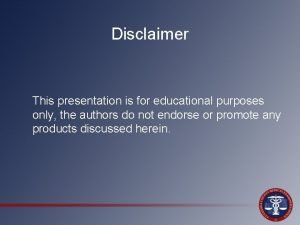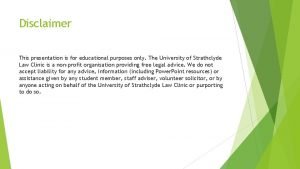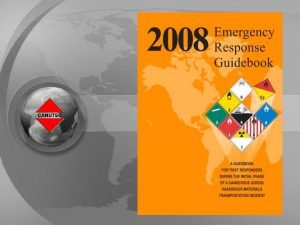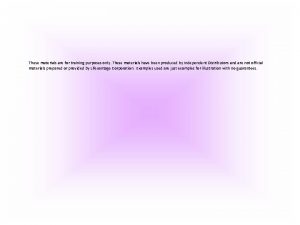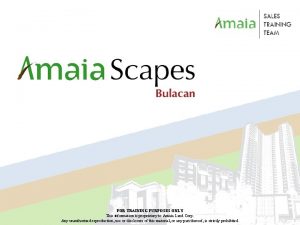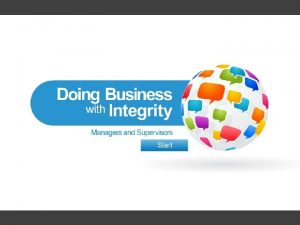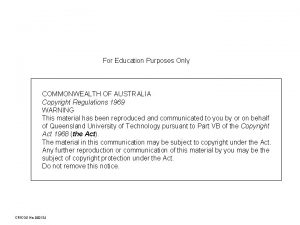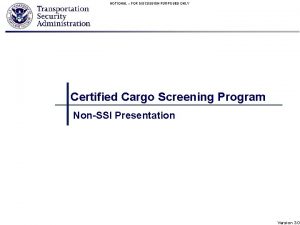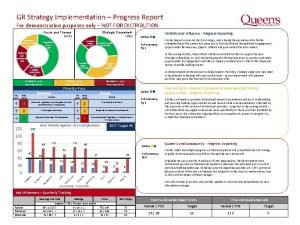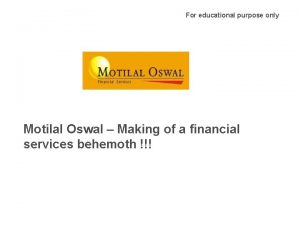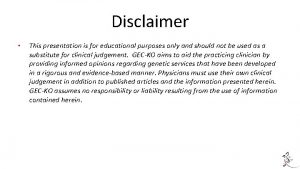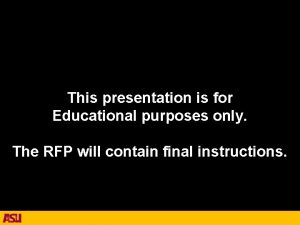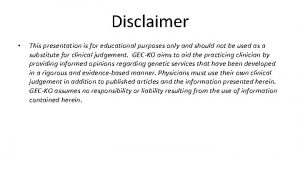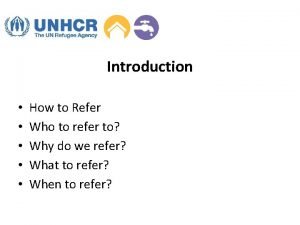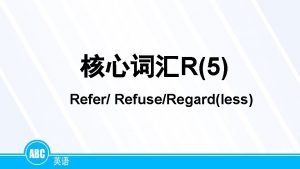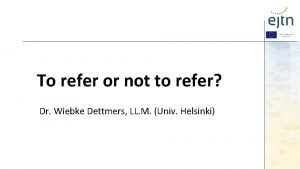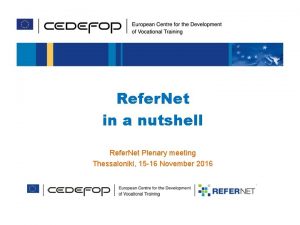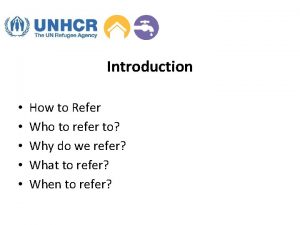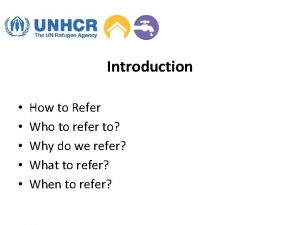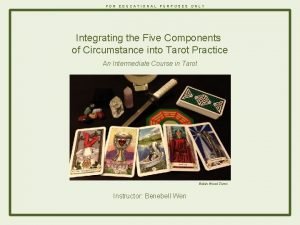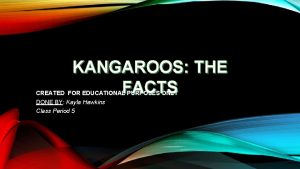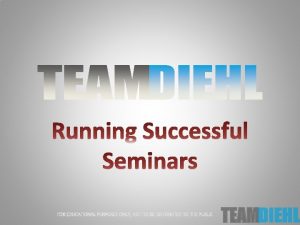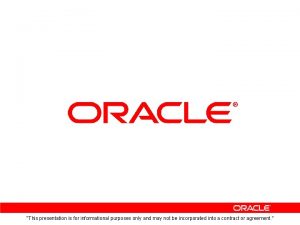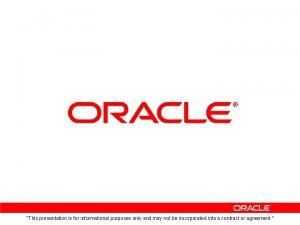This presentation is for educational purposes only Refer










































































- Slides: 74

This presentation is for educational purposes only Refer to the project RFP for specific details and instructions If there any inconsistencies, the RFP and Amendments shall take precedence over this presentation

Best-Value Procurement University of Manitoba Arizona State University 9/11/13

19 Years | 210+ Publications | 550+ Presentations 1, 500+ Projects | $4. 6 Billion Procured

What is Best-Value? • Win-Win • Client: – Outsource to experts – Higher performance – Less management and resources • Vendor – Control of project/service – Ability to increase profit by maximizing their efficiency 4

Traditional Model • • • Client assumes they have expertise Client makes decisions on what they think they need to be successful Client prepares minimum standards Client prepares documents that describe everything they need/require Client competes vendors, but primary award factor is cost RESULTS Inconsistent performance Inefficiencies Lack of performance metrics Lack of accountability 5

Best-Value Model • • • Experts know more about the project/service than the client Client does their best job at defining what they think they need Experts act in the clients best interest Expert can optimize the service by reducing inefficiencies Think about the project, use past experience, and layout a specific plan Focus on the key personnel, lessons learned, and risk mitigation What the Owner Described What the Consultant Specified What the Contractors Installed What the Owner Really Needed 6

Best-Value Process

Factors For Success • Fair (state/follow rules) • Open (open to all with experience) • Impartial and Transparent (minimize evaluator bias / provide debriefing) • Efficient (minimize efforts) • Award based on value 8

Best Value System 9

Phase 2 10

Phase 2 is Most Critical High Level Overview Vendors Are Experts 52 Days Details Verify Everything 32 Days 11

What is the Clarification Period? (Proactive vs Reactive) Minimize All Surprises!!!

What Could Cause a Surprise • • • Delivering something that doesn’t work Delivering something that isn’t what the client is expecting Delivering something that isn’t what the client needed Requiring the client to do something (that they did not know they had to do) Requiring things from the client that they cannot provide Expecting that something will happen as planned Assuming that things are clear and understandable Assuming that things will be done/occur as planned Changes that impact cost Changes that impact time Poor satisfaction 13

What is the Greatest Source of Risk? 14

How To Minimize Surprises • Perform a detailed cost verification – – – Detailed cost breakdown Identify why the cost proposal may be significantly different from competitors Review big-ticket items Review value added options Identify how payments will be made and all expectations regarding finances Provide a pro-forma • Carefully preplan the project in detail – – – Coordinate the project/service with all critical parties Revisit the sites to do any additional investigating Prepare a detailed project plan Provide a marketing plan Provide a transitioning plan & schedule (if the Offeror is not the incumbent) 15

How To Minimize Surprises • Align expectations – – – – Identify any potential deal breakers Clearly identify what is included and excluded in the proposal Review any unique requirements with the University Clearly identify University roles and responsibilities Review and approve all contract terms and conditions Introduce the vendors critical personnel to the University team Provide plan for critical staff retention and plan if these individuals leave • Identify and mitigate all project risks – Address all client concerns and risks – Address all risks identified by other proposers – Address all risks that occurred on previous past projects 16

How To Minimize Surprises • Identify and mitigate all uncontrollable risks – – Identify all risks or activities not controlled by the Offeror Identify the impact of the risks Identify what the University can do to mitigate the risks Address how unforeseen risks will be managed • Identify all assumptions – Prepare a list of all proposal assumptions (with associated impacts) • Performance reports and metrics – – Identify how the Offeror will track and document their performance Provide an actual monthly performance metric report Identify how the University will document this service as a success Review the Weekly Risk Report 17

Pre Planning Reduces Risk 52 Days 32 Days 18

Pre Award Document 1. Financial Summary (financial details, how funding will work, etc) 2. Transition Plan & Schedule (showing major milestones, risky activities, client actions, etc) 3. Project Risks/Concerns (all controllable risks/concerns, all non-controllable risks/solutions) 4. Assumptions (all project assumptions with associated impacts, identify what you need from the client and have a plan for obtaining it, roles and responsibilities of the client, etc ) 5. Performance Metrics (how the vendor will monitor performance, document success, metrics used, frequency, baseline for comparison, how will it assist the client, etc) 6. Scope of Work (plan of action, detailed work plan, how technical requirements will be met, baseline expectations, implementation plan, transitional plan, staffing plan, communication plan, training plan, organization change plan, what’s included, excluded, etc) 7. Contract (language, terms and conditions, etc) 19

Guide Us / Help Us See & Understand 20

Pre Planning Reduces Risk • • • Financial Summary Project Plan Project Risks/Concerns Assumptions Performance Metrics Contract 21

Keep Phase 2 In Mind During Phase 1 22

Best Value System 23

Your Proposal Must Minimize Surprises • Delivering something that doesn’t work • Delivering something that isn’t what the client is expecting • Delivering something that isn’t what the client needed • Changes that add more cost • Changes that add more time 24

Questions • All proposers must meet the minimum requirements / objectives • If a proposer does not understand, they must ask a question prior to submitting a proposal. Fax/Email the University Representatives below: – Procurement University Representative - Paul Dugal – Technical University Representative - Andrea Edmunds • If a proposer cannot meet a requirement, they must inform the client prior to proposing – Identify which requirement cannot be met – Provide recommendations or alternatives that the client may consider – The client will then issue an addendum with their response 25

Proposal Package • Any proposal that does not adhere to the requirements in this RFP will be deemed non responsive and rejected. 1. Attachment A – Proposal Form 2. Attachment B* – Team Qualifications 3. Attachment C* – Project Plan 4. Attachment D* – Risk Assessment Plan 5. Attachment E* – Value Assessment Plan 6. Attachment F – Reference List 7. Attachment G – Survey Questionnaires 8. Attachment H – Past Performance Information Scores 9. Attachment I – Cost Proposal Form 10. A CD or USB containing the proposal as required in Section 4 * Indicates that the entire Attachment must be anonymous. These Attachments must NOT contain any names (company, personnel, project, product, etc. ) that can be used to identify the Offeror. 26

Criteria and Weights No Criteria Weights 1 Total Financial Contribution 300 2 Interview of Onsite General Manager 300 3 Risk Assessment Plan 150 4 Value Assessment Plan 100 5 Team Qualifications 50 6 Past Performance Information – Firm 50 7 Past Performance Information – General Manager 50 Total Points: 1, 000 Points 27

Dominant Information A B C 10 OZ $3. 75 10 OZ $3. 50 10 OZ $3. 99 28

Which would you buy? (If you need to buy Cocoa Puffs) A 10 OZ $3. 50 B C 12 OZ $1. 25 14 OZ $2. 99 29

“Dominant Information” Scenario A Scenario B 30

Attachment A – Proposal Form 31

Attachments B, C, D, E • Attachments B-E consist of the written proposal • Offerors must use Attachments as the templates to fill-out • Offerors are NOT allowed to re-create, re-format, or modify the template (cannot alter font size, font type, font color; add colors, pictures, diagrams, etc. ). • In order to minimize any bias, the evaluated proposal documents MUST NOT contain any names that can be used to identify who Proposer is (such as company names, personnel names, project names, or product names). • Pay attention to page limits! 32

How The Submittal Process Works Average Score Proposal. Documents Form Non-Evaluated Purchasing Contracting Officer Submittal (1 page) Proposal Form Evaluated Documents (1 page) Evaluation Members

Attachment B – Team Qualifications • Describe the team of key personnel that will be assigned to this project along with key performance metrics – – – Years with your company Years of experience in current position Number of similar projects Average customer satisfaction ratings Documented performance improvements Awards and achievements • Differentiate your capability to meet the requirements of this service by aligning your expertise. • The Team Qualification plan must NOT exceed 1 page 34

Attachment C – Project Plan • Demonstrate to the University that the Offeror can visualize what they are going to do before they do it. The Project Plan consists of the following sections: – Proposal Summary – describe how the Offeror will meet the University’s expectations in major activities or tasks. – Project Assumptions – a summary of the major assumptions that have been made in preparing the proposal. – Roles, Responsibilities, Expectations – brief summary of the expectations and responsibilities that the Offeror has of the University or University personnel. – Clarification Period Schedule – a high level schedule that included dates of when the Offeror will accomplish all of the requirements of the Clarification Period • The Project Plan must NOT exceed 4 pages 35

Attachment D – Risk Assessment Plan • Identify and prioritize all major risks (applicable to this project) that may impact a successful delivery of the project. • Risk = not completing on time, not finished within budget, generating change orders, or sources of dissatisfaction to the owner. • The risk should be described in non-technical terms and should contain enough information to understand why the risk is a valid risk. Proposer must also explain how it will avoid or minimize the risks from occurring. • Solutions must be nontechnical, logical, easily understood, or contain verifiable performance information. 36

Risk Assessment Plan • Assessment of Controllable Risks: risks, activities, or tasks that are controllable by Proposer, or by entities/individuals that are contracted to by Proposer. This includes things that are part of the technical scope of what Proposer is being hired to do. Project risk that other vendors have due to lack of experience and expertise • Assessment of Non-Controllable Risks: risks, activities, or tasks that are not controllable by Proposer. This may include risks that are controlled by Agency, Agency’s representatives, or completely uncontrollable. Although these risks may not be controlled by Proposer, Proposer must identify a strategy that can be followed or used to mitigate these risks. 37

To Be Considered “Dominant”, Risks/Solutions Should: • Be clear and concise • Non-technical descriptions • Logical • Measurements that document time, quality, and cost • Document performance results

Risk Assessment Example Controllable Risk • VENDOR 1 – RISK: This project requires a significant amount of concrete. The cost of concrete has been rapidly escalating over the past year. – SOLUTION: The owner can be assured all risks associated with concrete escalations will be eliminated because we offer the benefit of an experienced project team that includes the most detailed, prequalified and extensive list of subcontractors and suppliers, from around the world. • VENDOR 2 – RISK: The cost of concrete has been rising drastically over the past year. Since this project requires a substantial amount of concrete, cost is a risk. – SOLUTION: To minimize this risk, we have secured and signed a contract with a local concrete manufacturer to prevent any increase in cost during the duration of this project. 39

Risk Assessment Example Controllable Risk • VENDOR 1 – RISK: Noise from our demolition may result in student/staff complaints (since we will be doing demo in an in-operational library during finals week). – SOLUTION: We will work with the user to minimize the impact of noise from demolition. • VENDOR 2 – RISK: Noise from our demolition may result in student/staff complaints (since we will be doing demo in an in-operational library during finals week). – SOLUTION: To minimize this risk, we have planned to demolition during off hours and weekends. We will also install rubber sheets on the floors to diminish noise and vibrations. Both solutions can be performed within your budget. 40

Risk Assessment Example Controllable Risk RISK: A poor roofing system can result in roof leaks, which may inconvenience building occupants, increase complaints, increase maintenance, damage building contents, and be a source of mold issues. Vendor A Solution: • To minimize this risk, our proposed roofing system has been installed on over 400 roofs and has had an average roof age of 18 years, in which 99% of the roofs don’t leak and 100% of the end clients are satisfied. Vendor B Solution: • To minimize this risk, we are proposing a thermally-welded roofing system that has a tensile strength of 2, 130 PSI, elongation of 300%, tear strength of 312 lbs, has been tested for 10, 000, and has a cold brittleness of -30°C. 41

Risk Assessment Example Non-Controllable Risk • VENDOR 1 – RISK: The local water company must have the water turned on by June in order for us to properly water the newly installed recreational fields (or the grass will die). – SOLUTION: We will coordinate and plan our schedule with the water company as soon as the award is made to make sure that we get water to the site to irrigate the fields. • VENDOR 2 – RISK: The local water company must have the water turned on by June in order for us to water the newly installed fields (or the grass will die). On past projects, the water company has failed to meet the schedule 90% of the time. – SOLUTION: To minimize this risk, we will coordinate our schedule with the water company as soon as we are awarded the project. If they fail to meet our schedule, we will setup and connect temporary waterlines to the nearby fire hydrants and we will also have water trucks on-site to irrigate the fields. 42

Risk Assessment Example Controllable Risk • RISK: Major risk items typically associated with transit implementations revolve around change management and business process impact. New technology implementations create change for the users. Change often causes issues with technology adoption. Requirements and scope creep also creates challenges. Systems may have thought a certain technology or component was incorporated in the RFP and/or needs assessment process that is not included in the actual scope of work or contract. Communication is also an area that can be a challenge. • SOLUTION: A clearly defined scope of work and communication of the scope at the beginning of the project minimizes scope creep. If there is a discrepancy, scope or requirements can be discussed early on in the process versus at the end of the process. Communication is the key to successful implementations. Change management and business process re-engineering for organizations can be minimized at the technology and management levels. Management can get early buy-in at the “grass roots” level and include them in the technology planning process. The Team focuses on providing very configurable and flexible tools to minimize process re-engineering tasks. The Team focuses on automating existing business processes and providing additional tools to improve those processes that need to be improved such as data management….

“If you can't explain it simply, you don't understand it well enough!” 44

Attachment E – Value Assessment Plan • Opportunity to identify any value added options or ideas that may benefit the Owner and Agency. • This may include ideas or suggestions on alternatives in implantation strategies, timelines, project scope, equipment, goals, financing, etc. • All value added ideas must be logical and/or based on verifiable performance metrics. • Value added ideas must NOT be included in the cost proposal. Prior to award, the Owner will determine if the value added items will be accepted or rejected. 45

Example: Value Added Items • Reroofing this building will not stop all water leaks. The majority of the leaks are caused by cracks in the parapet walls, broken/missing glass, and poor caulking. 46

Example: Value Added Items • You can save 20% in your cost if you substitute the T-3 lighting system for the T-2. The T-3 lights are newer state-of-the-art systems that are known industry wide as the best systems. • If we can alter the hours of operation at Site B, we can increase revenue overall revenue by 5%. This may be an inconvenience for a small number of people (less than 50 students) during this time period, but the revenue gain is considerable.

Example: Value Added Items • Idea: Purchase “Concurrent Licenses” instead of “Named Licenses” • Why: In a “Named Licensing” model, you must purchase a license for every user and only that particular user can access the software. If that named user is in meetings, on vacation, or not using the system, the license cannot be utilized. In a “Concurrent Licensing” model, the system loans out the licenses to users as they log in. If a user is inactive, the server releases the license and allocates the license to the next user. • Expected Benefit: The advantage of the concurrent licenses is that the Agency will not have to purchase licenses that are not being used, which can result in approximately 20%-30% savings in cost. 48

Example: Value Added Items • Current Requirement: The current design requires a substantial number of cast-in-place box culverts. This requires us to create forms (which may be difficult in specific locations), and then we will have to wait for the concrete to cure. • Alternate: If we can use pre-cast culverts we can save approximately 5% in cost and reduce overall schedule by 10%. Pre-cast culverts can be made to the same specifications as the cast-in-place culverts, and we have found them to be higher in quality since they can be created in a closed environment. • Documented Performance: We have done this on over 20 projects (similar in scope to this project) and have had high customer satisfaction.

Things to Avoid • General Statements: – Our employees will wear safety equipment (hard hats, vests, etc) – Safety: Our goal is to have no accidents or deaths – We will put a fence around the site to prevent outside access • Marketing data: – Our company is known worldwide as a leader in… – We will use our long history to… – We will use state-of-the-art process to… • Technical data: – The system we propose has 200% elongation and 600 psi tensile strength – The product will pass the ASTM-568 a test. • Transferring risk back to client: – We will work with the owner to resolve issues… – We will have team meetings / partnering meetings with the owner…

Critical Formatting Requirements • Proposal is limited to – 1 Pages = Assessment of Controllable Risks – 1 Pages = Assessment of Non-Controllable Risks – 1 Pages = Assessment of Value Added Ideas 51

Remember… • Be clear and concise • Non-technical descriptions / solutions • Logical • Measurements that document time, quality, and cost • Document performance results / verifiable results

How The Submittal Process Works Average Score Proposal. Documents Form Non-Evaluated Purchasing Contracting Officer Submittal (1 page) Proposal Form Evaluated Documents (1 page) Evaluation Members

Evaluation Committee • Will be used to evaluate specific portions of the Proposal • Evaluators will not be provided with the names of any Proposers, product names, cost, or any additional information • Evaluators will independently (not as a group or consensus) review and score the items comparatively to one another • Objective of the scoring is to not make a decision (looking for “dominant” differential) • Evaluations will be scored on a 1/5/10 scale – “ 10” = Dominantly higher value than the average (clearly shows differential) – “ 5” = About average (insufficient information to make a clear decision) – “ 1” = Dominantly below the average (clearly shows differential) 54

Past Performance Information • PPI will be collected on the following Entities: – The Firm – Onsite General Manager (Individual) • Each Entity must prepare and submit a Reference List, Survey Questionnaire, and Past Performance Information Scores Step 1 Step 2 ENTITY Vendor Step 3 Step 4 Step 5 Prepare Reference List Prepare and Send Survey Questionnaires to Past Clients Collect/Receive Completed Surveys Enter data into Reference List Package all material (Reference List and Surveys) and Submit 55

Reference List • Each Entity must submit a list of clients that will evaluate Entity's performance. • The maximum number of references that can be submitted is 5 for each Entity. • The past projects must be installed and operational • The past projects must be related to food services • The reference list must contain different projects and clients • The client must complete the survey • The University of Manitoba cannot be used as a reference • Each Entity can use the same references provided that they were used or applied on that particular project. 56

Survey Questionnaire • For each Entity, Proposer must prepare, send out, and collect survey questionnaires to each individual listed on the Reference List. • Proposer must modify so that the surveys are returned back to the Proposer. • All returned surveys MUST be evaluated AND signed by the client. • Returned surveys must be packaged together and submitted with Proposer's proposal (Proposer should keep a copy of all returned surveys for Proposer's records). 57

Past Performance Information Score • Proposer shall input the survey scores, and “Overall Average Score” • Proposer shall also count the “Total Number of Returned Surveys” • Client may contact the reference to clarify or to obtain additional information. If the reference cannot be contacted, the survey may be deleted. • The Client may also adjust the scores if the client determines that the criteria/requirements have not been followed. 58

Attachment I – Cost Proposal • Total 10 -Year Financial Contribution • Overview of Commissions • Transitioning Costs (Offeror shall be responsible for all costs associated for transitioning the service from the incumbent to the Offeror) • Overview of Major Capital Investments • Value Added Options 59

Shortlisting • A University Procurement Representative will create a linear matrix model to assist in analyzing and prioritizing the responsive Proposals based on the submitted information. • The model will analyze: Cost, Risk Assessment Plan, Value Assessment Plan, Team Qualifications, and Past Performance Information. This model will assign points based on the normalized distance that a score is from the best score. • A University Procurement Representative will present the results of the model to the Evaluation Committee, which will then identify the top twoto-three highest ranking proposals, and identify them as the Shortlisted Offerors. The Evaluation Committee reserves the right to increase or decrease the number of proposals in this list based on the overall competitiveness of the proposals. 60

Key Personnel Interviews • The University will conduct interviews with the Onsite General Manager from each of the Shortlisted Offerors. • This individual must be the same person that is listed in the Offeror’s Proposal (Attachment A). No substitutes, proxies, phone interviews, or electronic interviews will be allowed. Individuals who fail to attend the interview on the date/time specified will be given a “ 1” score, which may jeopardize the Offeror’s competitiveness. • Interviews are expected to last approximately 30 minutes per individual. • No other individuals (from the Offeror’s organization) will be allowed to sit in or participate during the interview session. Interviewees may not bring notes or handouts. The University will interview individuals separately. Interviewees will be prohibited from making any reference to their proposed financial contributions. The University may request additional information prior to interviews and may request to interview additional personnel. 61

Interview Comments Goal Is To Minimize Risk “I have no idea why I am here today”…“My boss called me last night and told me to show up for this interview” - $10 Million Project “I did not participate at all in preparing our proposal” “I am not currently employed by this company, but if we win this project, they will then hire me” - $25 Million Service Project “I have never managed a project of this size/scope” - $30 Million Project “There is no risk on this project” - Large IT Project “The greatest risk that I always face, is how to accomplish all of the things that our sales team promised we could do” – Cleanroom Design Project 62

Final Prioritization 63

Financial Reasonableness • If the highest ranked Offeror’s total financial proposal is within 5% of the next highest ranked Offeror’s total financial proposal, the University will proceed to invite the highest ranked Offeror to the Clarification Period. • If the highest ranked Offeror’s total financial proposal is 5% (or more) lower than the next highest ranked Offeror’s total financial proposal, the University reserves the right to invite the second highest ranked Offeror to the Clarification Period. 64

Phase 2 • • • Financial Summary Project Plan Project Risks/Concerns Assumptions Performance Metrics Contract 65

Best Value System AWARD 66

Best Value System 67

Weekly Risk Reporting System • Spreadsheet that documents all risks on the service • Risk = Anything that may impact performance or financial contributions to the University. Risks can be caused by the Offeror or the University • Report must be submitted on Friday of every week (until service is complete) • The WRRS does not substitute or eliminate weekly progress reports or any other traditional reporting systems or meetings (that the Offeror may perform or may be required to perform). 68

Performance Reporting • The Offeror will be required to document the performance of its services on a monthly, quarterly, and yearly basis. • The monthly reports shall provide dominant information on the service provided, including (but not limited to): 1. Number of students served for meal plan options 2. Amount of capital invested along with the associated depreciation schedules 3. Amount of revenue generated with the ability to differentiate on a per outlet and/or per hour basis 4. Average check per customer 5. Total amount of revenue paid to the University • The Contractor will also be required to collect and compile student satisfaction surveys once per year. 69

Best Value System • • • Proposal ($) Past Performance Team Qualifications Risk Assessment Value Assessment Interviews • Pre-Planning & Clarification • • • Award Weekly Reporting Post Award Metrics Final Documentation Update PPI 70

Suggestions ü Identify who your best people are (done through measurements) ü Have your best people sit down in a room and think about this project ü Adapt their comments/ideas into your Risk and Value Assessment Plans ü Correlate any suggestions/ideas/solutions to documented performance ü Minimize marketing (risk of reformatting, names, words, etc. ) ü Follow all formatting requirements (no names, page limits) ü Be dominant ü Be simple, non-technical, and logical ü Picture what it takes to make the client very happy at the end 71

Anticipated Schedule No 1 2 3 4 5 6 7 8 9 10 Activity Project Announcement Pre-Proposal Conference Site Walk Deadline to Submit Questions/Inquiries Proposal Due Date (4: 00 PM Winnipeg Time) Interviews Clarification Period Anticipated Date of Award Transition Period Start of Service Date 08/26/13 09/11/13 09/23/13 10/17/13 10/23/13 10/28/13 - 11/29/13 12/12/13 1/1/14 - 3/30/14 4/1/14 72

Project Overview • The University is looking to secure services equal to, or better than, the level of service currently provided. The primary goals of this RFP are to increase financial return to the University and to increase satisfaction to the University & Students • This contract will be a commission-based structure and commence on April 1, 2014. The term of this contract is ten (10) years. • Vendor is responsible for all transitioning costs • Required minimum capital investment and buyout (by 4/1/14): – $560, 898 for capital equipment buyout; – Approximately $25, 000 for Noodles & Soup renovation (currently underway); – Between $225, 000 -$400, 000 for the Starbucks renovation at Bannatyne Campus 73

Comments / Questions WWW. PBSRG. COM 74
 For school purposes only
For school purposes only Disclaimer for educational purposes
Disclaimer for educational purposes Erg yellow section
Erg yellow section For training purposes only
For training purposes only For discussion only
For discussion only For training purposes only
For training purposes only Training purposes only
Training purposes only Education purposes only
Education purposes only Tsa certified cargo screening program
Tsa certified cargo screening program For demonstration purposes only
For demonstration purposes only For discussion purposes only
For discussion purposes only Educational purpose only #
Educational purpose only # Take only photos leave only footprints
Take only photos leave only footprints Fspos
Fspos Novell typiska drag
Novell typiska drag Nationell inriktning för artificiell intelligens
Nationell inriktning för artificiell intelligens Vad står k.r.å.k.a.n för
Vad står k.r.å.k.a.n för Shingelfrisyren
Shingelfrisyren En lathund för arbete med kontinuitetshantering
En lathund för arbete med kontinuitetshantering Särskild löneskatt för pensionskostnader
Särskild löneskatt för pensionskostnader Tidbok yrkesförare
Tidbok yrkesförare Anatomi organ reproduksi
Anatomi organ reproduksi Vad är densitet
Vad är densitet Datorkunskap för nybörjare
Datorkunskap för nybörjare Boverket ka
Boverket ka Debatt mall
Debatt mall Magnetsjukhus
Magnetsjukhus Nyckelkompetenser för livslångt lärande
Nyckelkompetenser för livslångt lärande Påbyggnader för flakfordon
Påbyggnader för flakfordon Formel för lufttryck
Formel för lufttryck Publik sektor
Publik sektor Lyckans minut erik lindorm analys
Lyckans minut erik lindorm analys Presentera för publik crossboss
Presentera för publik crossboss Jiddisch
Jiddisch Vem räknas som jude
Vem räknas som jude Treserva lathund
Treserva lathund Luftstrupen för medicinare
Luftstrupen för medicinare Claes martinsson
Claes martinsson Centrum för kunskap och säkerhet
Centrum för kunskap och säkerhet Programskede byggprocessen
Programskede byggprocessen Mat för unga idrottare
Mat för unga idrottare Verktyg för automatisering av utbetalningar
Verktyg för automatisering av utbetalningar Rutin för avvikelsehantering
Rutin för avvikelsehantering Smärtskolan kunskap för livet
Smärtskolan kunskap för livet Ministerstyre för och nackdelar
Ministerstyre för och nackdelar Tack för att ni har lyssnat
Tack för att ni har lyssnat Referatmarkeringar
Referatmarkeringar Redogör för vad psykologi är
Redogör för vad psykologi är Borstål, egenskaper
Borstål, egenskaper Tack för att ni har lyssnat
Tack för att ni har lyssnat Borra hål för knoppar
Borra hål för knoppar Orubbliga rättigheter
Orubbliga rättigheter Fr formel
Fr formel Tack för att ni har lyssnat
Tack för att ni har lyssnat Steg för steg rita
Steg för steg rita Verksamhetsanalys exempel
Verksamhetsanalys exempel Tobinskatten för och nackdelar
Tobinskatten för och nackdelar Blomman för dagen drog
Blomman för dagen drog Datumr
Datumr Egg för emanuel
Egg för emanuel Elektronik för barn
Elektronik för barn Antikt plagg i rom
Antikt plagg i rom Strategi för svensk viltförvaltning
Strategi för svensk viltförvaltning Kung som dog 1611
Kung som dog 1611 Ellika andolf
Ellika andolf Sju för caesar
Sju för caesar Tack för att ni lyssnade
Tack för att ni lyssnade Samlade siffror för tryck
Samlade siffror för tryck Lyrik texte
Lyrik texte Inköpsprocessen steg för steg
Inköpsprocessen steg för steg Rbk mätning
Rbk mätning Ledarskapsteorier
Ledarskapsteorier Cellorov
Cellorov Myndigheten för delaktighet
Myndigheten för delaktighet Frgar
Frgar
